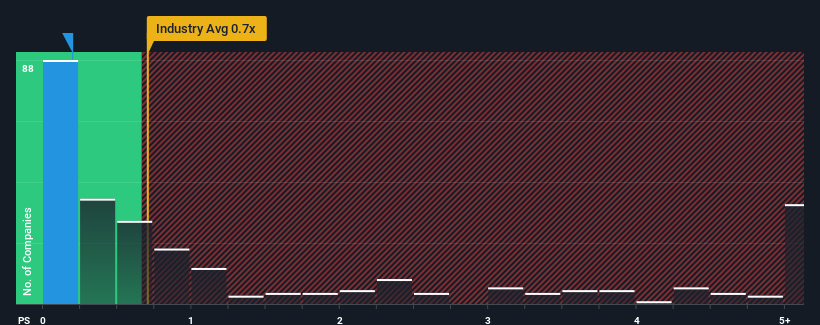- Hong Kong
- /
- Real Estate
- /
- SEHK:488
Lai Sun Development Company Limited's (HKG:488) Shares Bounce 49% But Its Business Still Trails The Industry
Lai Sun Development Company Limited (HKG:488) shareholders would be excited to see that the share price has had a great month, posting a 49% gain and recovering from prior weakness. But the last month did very little to improve the 52% share price decline over the last year.
Even after such a large jump in price, Lai Sun Development may still be sending buy signals at present with its price-to-sales (or "P/S") ratio of 0.2x, considering almost half of all companies in the Real Estate industry in Hong Kong have P/S ratios greater than 0.7x and even P/S higher than 3x aren't out of the ordinary. Nonetheless, we'd need to dig a little deeper to determine if there is a rational basis for the reduced P/S.
Check out our latest analysis for Lai Sun Development

What Does Lai Sun Development's P/S Mean For Shareholders?
Revenue has risen firmly for Lai Sun Development recently, which is pleasing to see. One possibility is that the P/S is low because investors think this respectable revenue growth might actually underperform the broader industry in the near future. Those who are bullish on Lai Sun Development will be hoping that this isn't the case, so that they can pick up the stock at a lower valuation.
Want the full picture on earnings, revenue and cash flow for the company? Then our free report on Lai Sun Development will help you shine a light on its historical performance.How Is Lai Sun Development's Revenue Growth Trending?
Lai Sun Development's P/S ratio would be typical for a company that's only expected to deliver limited growth, and importantly, perform worse than the industry.
Retrospectively, the last year delivered a decent 13% gain to the company's revenues. The latest three year period has also seen a 5.1% overall rise in revenue, aided somewhat by its short-term performance. Accordingly, shareholders would have probably been satisfied with the medium-term rates of revenue growth.
Comparing that to the industry, which is predicted to deliver 3.7% growth in the next 12 months, the company's momentum is weaker, based on recent medium-term annualised revenue results.
With this information, we can see why Lai Sun Development is trading at a P/S lower than the industry. It seems most investors are expecting to see the recent limited growth rates continue into the future and are only willing to pay a reduced amount for the stock.
The Final Word
The latest share price surge wasn't enough to lift Lai Sun Development's P/S close to the industry median. Using the price-to-sales ratio alone to determine if you should sell your stock isn't sensible, however it can be a practical guide to the company's future prospects.
As we suspected, our examination of Lai Sun Development revealed its three-year revenue trends are contributing to its low P/S, given they look worse than current industry expectations. At this stage investors feel the potential for an improvement in revenue isn't great enough to justify a higher P/S ratio. Unless the recent medium-term conditions improve, they will continue to form a barrier for the share price around these levels.
Having said that, be aware Lai Sun Development is showing 3 warning signs in our investment analysis, and 2 of those are concerning.
If companies with solid past earnings growth is up your alley, you may wish to see this free collection of other companies with strong earnings growth and low P/E ratios.
New: AI Stock Screener & Alerts
Our new AI Stock Screener scans the market every day to uncover opportunities.
• Dividend Powerhouses (3%+ Yield)
• Undervalued Small Caps with Insider Buying
• High growth Tech and AI Companies
Or build your own from over 50 metrics.
Have feedback on this article? Concerned about the content? Get in touch with us directly. Alternatively, email editorial-team (at) simplywallst.com.
This article by Simply Wall St is general in nature. We provide commentary based on historical data and analyst forecasts only using an unbiased methodology and our articles are not intended to be financial advice. It does not constitute a recommendation to buy or sell any stock, and does not take account of your objectives, or your financial situation. We aim to bring you long-term focused analysis driven by fundamental data. Note that our analysis may not factor in the latest price-sensitive company announcements or qualitative material. Simply Wall St has no position in any stocks mentioned.
About SEHK:488
Lai Sun Development
Invests in, develops, leases, and sells real estate properties in Hong Kong, Mainland China, Macau, the United Kingdom, Vietnam, and internationally.
Slightly overvalued with minimal risk.
Similar Companies
Market Insights
Community Narratives



